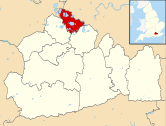King George VI Reservoir
The King George VI Reservoir in England lies to the south of Stanwellmoor near Stanwell and Heathrow. The reservoir was opened in November 1947 and named after the then reigning monarch King George VI. It is owned by Thames Water.
| King George VI Reservoir | |
|---|---|
 View across the reservoir | |
| Location | Surrey |
| Coordinates | 51.449075°N 0.502482°W |
| Type | Man made reservoir |
| Catchment area | River Thames |
| Basin countries | United Kingdom |
| Built | 1937 |
| Surface area | 140 ha (350 acres) |
| Max. depth | 17 m (56 ft) |
| Water volume | 15.88 Gl (3.49×109 imp gal) |
| Islands | None |
The reservoir occupies 350 acres (1.4 km2) and holds 3,493 million imperial gallons (15,880,000 m3);[1] some sources state the capacity is 4,466 million gallons.[2] Its maximum height above the original ground level is 56 ft (17 m). The perimeter of the embankment is 5.23 km.[2] Like the other Lower Thames reservoirs, it is of traditional earthen dam construction, with a puddled clay core supported by ballast embankments built from materials excavated on site.[3] It is entirely man-made, as the area had no natural topographical features that could be dammed off to create a reservoir. To make inspecting the integrity of the reservoir easier, Thames Water maintains a commercial flock of sheep on the reservoir banks to keep the grass on the reservoir banks close-cropped.[4]
The tender for the reservoir of £1,292,000 was made in July 1937, the construction was undertaken by John Mowlem and Co. Limited.[2] The reservoir was completed in 1939 but was left empty due to the outbreak of the Second World War. It was reputed that a mock Clapham Junction railway station was built inside to confuse the Luftwaffe.[5] The reservoir was used for fog dispersal experiments in the development of the FIDO landing system.[6] It was formally opened by King George VI on 7 November 1947.[2]
This reservoir and the adjacent Staines Reservoirs receive their input from the River Thames at Hythe End just above Bell Weir Lock. There are two valve towers, an inlet tower near the south embankment and an outlet tower near the east embankment opposite the towers in the Staines reservoirs.The discharge from the reservoir enters the Staines Reservoirs Aqueduct which continues eastwards, passing the Water Treatment Works at Kempton Park, to supply the Water Treatment Works at Hampton. The other adjacent reservoir, Wraysbury Reservoir, is situated to the west on the other side of the M25.
The reservoir forms part of the Staines Moor Site of Special Scientific Interest. The reservoirs carry nationally important wintering populations of tufted ducks, pochard, goosander and goldeneye.
See also
- London water supply infrastructure
- List of SSSIs in Surrey
References
- Denis Smith Civil Engineering Heritage Thomas Telford 2001 ISBN 0-7277-2876-8
- "350-acre reservoir opening at Staines by the King today". The Times. 7 November 1947. p. 3.
- Henry Hewlett Long-Term Benefits and Performance of Dams (Proceedings the 13th Conference of the British Dam Society held at the University of Kent, June 2004) Thomas Telford 2004
- "The real-life reservoir dogs (press release)". PR Newswire. Thames Water. Retrieved 4 December 2016.
- Gallop, Alan (2005). Time Flies: Heathrow At 60. Stroud: Sutton Publishing. p. 36. ISBN 1-85310-259-8.
- Williams, Geoffrey (1995). Flying Through Fire. Grange Books. p. 8. ISBN 1-85627-900-6.CS1 maint: ref=harv (link)
